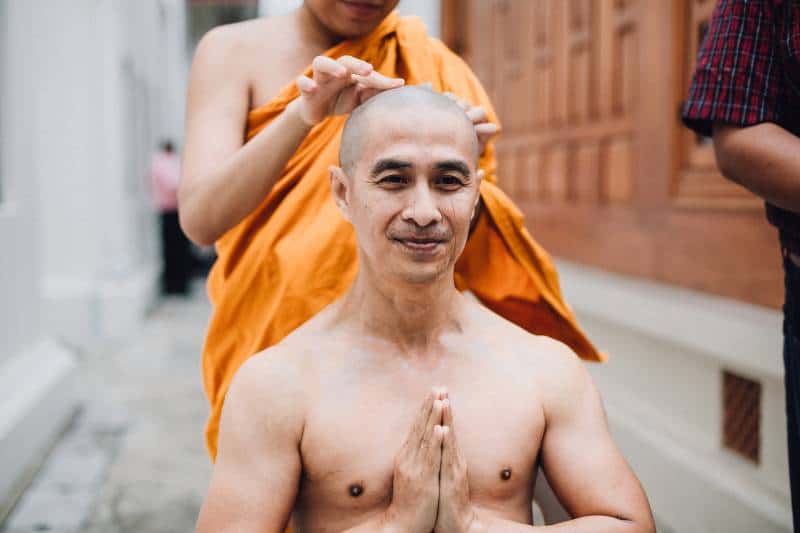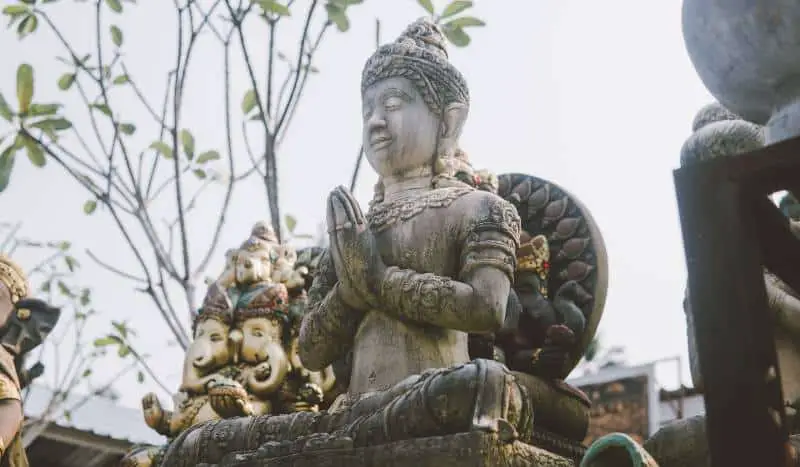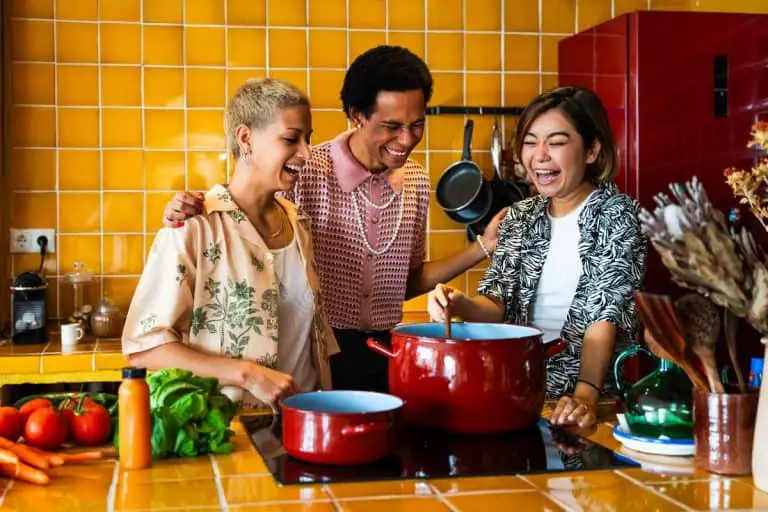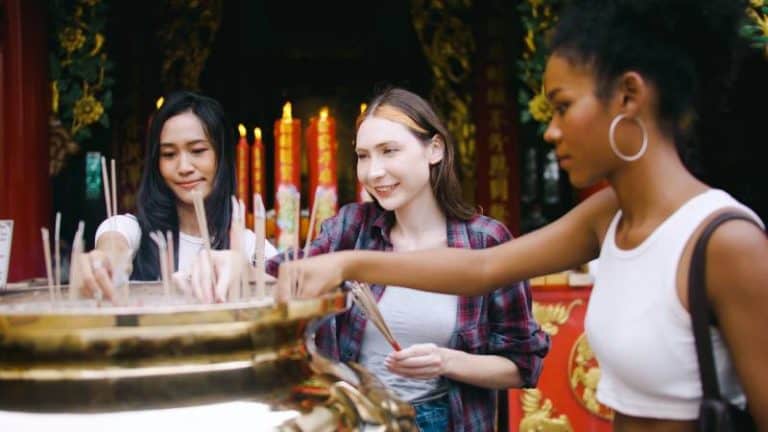Buddhism in Thailand: More Than Just Religion
Thailand is a country well known for its richness in culture, vibrant history, and spiritual practices. One of the major factors that contribute to Thai society today is Buddhism – an ancient Asian tradition that has been deeply embedded within the core of this Southeast Asian nation’s identity. Through centuries of study, meditation, and intricate ceremonies honoring revered Buddhist teachings, Thais have cultivated a deep-rooted sense of devotion toward their religion.
This article will provide an overview of how Thailand Buddhism has played a role in forming some integral aspects of Thai culture by examining its influence on architecture, artistry, philosophy as well as everyday customs and traditions upheld all throughout Thailand. By exploring these connections between Buddhism and Thailand’s cultural heritage more closely we can gain further insight into why it remains such a pivotal part of contemporary life in this captivatingly beautiful kingdom!
Buddhism, as the spiritual core, not only fosters harmony and stability within the Thai Nation but also facilitates the integration of diverse groups through various festive observances. These celebrations serve as a unifying force, bringing people together in perfect accord.
Key Takeaways
- Buddhism is more than just a religion in Thailand; it’s a way of life, influencing everything from art and architecture to moral values.
- Despite the challenges of modernization, Buddhist traditions remain deeply entrenched, guiding buddhist festivals, ceremonies, and daily practices.
- As Thailand evolves, there’s a continuous effort to balance and integrate age-old Buddhist principles with the demands and allure of contemporary life.

Origins and Spread of Buddhism in Thailand
Introduction to Theravada Buddhism
Buddhism, one of the world’s oldest and most profound religious traditions, found its way to the heart of Southeast Asia around two millennia ago. Thailand, known as the Land of Smiles, is home to a unique tapestry of cultural and spiritual practices, and Buddhism plays a paramount role in weaving this fabric. The origins of Buddhism in Thailand can be traced back to the early centuries of the Common Era when Indian maritime trade routes flourished and facilitated the transmission of religious ideas.
Historical records suggest that as early as the 3rd century BCE, emissaries from the Mauryan Indian emperor, Ashoka the Great, might have ventured to Southeast Asia to spread the teachings of the Buddha. These teachings found fertile ground in the Mon and Khmer kingdoms, which occupied regions of present-day Thailand. The Dvaravati Mon kingdom, for example, which thrived between the 6th and 11th centuries CE, is considered instrumental in sowing the seeds of Theravada Buddhism in the region.
The Sri Lankan Theravada tradition, rooted in the Pali Canon and the teachings of ancient Buddhist councils, was especially influential. By the 13th century, with the decline of the Mon and the rise of the Thai Kingdom of Sukhothai, Theravada Buddhism began to spread widely and was patronized by Thai monarchs. Over time, through the assimilation of local beliefs and traditions, it took on a character that was distinctly Thai.
Introduction to Theravada Buddhism
Theravada Buddhism, often termed “The School of the Elders,” represents the oldest extant branch of Buddhism. Derived from the Pali word “Thera,” meaning “elder monk,” Theravada places a strong emphasis on the preservation of the original teachings of the historical Buddha, Siddhartha Gautama. The core texts of Theravada, the Pali Canon or Tipitaka, are believed to be the most authentic representation of the Buddha’s teachings.
To provide a simple analogy, imagine a precious ancient manuscript that has been passed down through generations. While some people might be tempted to embellish or add their own interpretations, the guardians of Theravada would be those meticulously preserving and following the original words and meanings of this manuscript, ensuring its purity.
The practice of Theravada emphasizes individual enlightenment and the cultivation of wisdom, ethical conduct, and mental discipline. Central to its teachings is the Four Noble Truths which diagnose the human condition of suffering (dukkha) and provide a path, the Noble Eightfold Path, to its cessation. Monastic life, with monks and nuns taking on vows of celibacy and simplicity, plays a pivotal role in Theravada communities.
How Theravada Buddhism Became Dominant in the Region
Theravada’s ascendancy in Thailand was not a swift or linear process but rather a complex interplay of sociopolitical factors, royal patronage, and cultural exchanges.
- Royal Patronage: Thai monarchs, particularly during the Sukhothai and later Ayutthaya periods, extended generous patronage to Theravada Buddhism. King Ramkhamhaeng of Sukhothai, for instance, is celebrated for inscribing the earliest known Thai script and for endorsing Theravada as the state religion. These endorsements established monasteries, funded religious art, and promoted the ordination of monks, which bolstered the spread of Theravada principles.
- Cultural Exchanges with Sri Lanka: The close religious ties between Thailand and Sri Lanka played a substantial role. The two countries often exchanged monks to rejuvenate the monastic lineage and to ensure that the teachings remained true to the original scriptures. This reinforced the prominence of the Theravada tradition in the region.
- Synthesis with Local Beliefs: While the core tenets of Theravada were preserved, they were seamlessly integrated with indigenous animistic beliefs and Brahmanical practices. This synthesis made Theravada more accessible and relatable to the local populace. For instance, the Thai tradition of “making merit,” where laypeople offer food and essentials to monks, blends the Theravada emphasis on generosity with local customs of giving.
- Geopolitical Factors: Over time, as the neighboring kingdoms like the Khmer Empire waned in influence and the Thai kingdoms grew in power, the cultural and religious landscape also shifted. Theravada Buddhism, being the faith of the dominant Thai kingdoms, naturally saw an upsurge in followers.
The roots of Theravada Buddhism in Thailand run deep, nurtured by the historical, cultural, and geopolitical factors that have shaped the nation. The enduring presence of this tradition in Thailand is a testament to its ability to resonate with the spiritual yearnings of the Thai people and its adaptability in melding with the rich tapestry of local beliefs and customs.
Buddhist Practices and Traditions in Thai Culture
Buddhist Practices and Traditions in Thai Culture
The intricate blend of Buddhism with Thai culture has led to an array of practices and traditions that are integral to the everyday life of the Thai people. From daily rituals to annual festivals, Buddhist influences can be witnessed across various facets of Thai society.
Temple Visits and Merit-making:
- Temple Visits: The temple, or ‘Wat’, is not just a place of worship in Thailand but a focal point of community life. Thai people frequently visit a Buddhist temple to pay respects to the Buddha, seek guidance from monks, or simply find a moment of peace. Often adorned with golden stupas, intricate murals, and sacred relics, these temples are also repositories of Thai art, history, and culture.
- Merit-making: Central to Buddhist teachings is the concept of ‘making merit’ (in Thai, “ทำบุญ” or “tam boon”). It’s believed that performing good deeds purifies the mind and paves the way for a better rebirth. Common merit-making activities include offering food to Thai monks during their morning alms rounds, releasing captive animals like birds or fish, and donating to temples. To simplify, think of merit-making as a spiritual savings account; the more good deeds you deposit, the greater your spiritual wealth.
Meditation and Monks’ Ordination:
- Meditation: Meditation is an essential pillar of Theravada Buddhism and is widely practiced in Thailand. While monks engage in regular meditation, laypeople also attend retreats or sessions at temples. Vipassana, or ‘insight meditation’, is particularly popular, guiding practitioners to gain a deeper understanding of the nature of reality.
- Monks’ Ordination: Becoming a monk, even if temporarily, is a rite of passage for many Thai men. It’s seen as a way to gain merit for oneself and one’s family. Many young men choose to be ordained for a few weeks or months, especially during the Buddhist Lent (Khao Phansa). This period of monkhood teaches them discipline, humility, and the foundational tenets of Buddhism.
Festivals and Ceremonies:
- Loy Krathong: Celebrated during the full moon of the 12th month in the traditional Thai lunar calendar (usually in November), Loy Krathong is a festival of lights. Participants release beautifully decorated baskets or ‘krathongs’, made from banana leaves and adorned with flowers, candles, and incense, into rivers and waterways. This act symbolizes letting go of grudges and negative thoughts, paying respect to the water spirits, and seeking blessings for the future. Picture a serene night with thousands of glowing baskets floating on water, creating a mesmerizing spectacle of light.
- Songkran: Known internationally as the Thai New Year or the water festival, Songkran is celebrated from 13th to the 15th of April. While it’s famous for its jovial water fights, Songkran has deep Buddhist roots. Traditionally, people visit temples, offer food to monks, and cleanse Buddha statues with fragrant water. This ritualistic cleansing symbolizes purification, washing away sins, and welcoming the New Year with a fresh start.
In essence, Buddhist practices in Thai culture are not just confined to temples or special occasions. They permeate daily life, guiding values, actions, and interactions. Through temple visits, meditation, festivals, and more, the Thai people have interwoven the teachings of Buddhism with their cultural tapestry, creating traditions that are both deeply spiritual and uniquely Thai.
Buddhism and Thai Art & Architecture
Buddhism, which has been woven into the very fabric of Thai culture, profoundly influences its art and architecture. Over the centuries, this integration has given rise to breathtaking temples, historical landmarks, and deeply meaningful artworks that encapsulate the essence of the Thai people’s spiritual journey and the nation’s unique aesthetic sensibilities.
The majestic temples in Thailand, locally known as ‘wats’, are not just places of worship but also reflections of the intricate relationship between Thai culture and Buddhist philosophy. One of the most iconic of these is Wat Phra Kaew in Bangkok, which houses the sacred Emerald Buddha. Its intricate designs, shimmering golden stupas, and the detailed murals on the temple walls narrate tales from the Jataka stories, which depict the previous lives of the Buddha. These stories, rendered in vibrant colors and with meticulous attention to detail, serve as a testament to the craftsmen’s dedication and reverence for Buddhist teachings.
But beyond these grand temples, smaller architectural wonders are scattered throughout Thailand. For example, the teakwood Wat Phan Tao in Chiang Mai, while smaller in scale, offers a deep sense of serenity with its ornate wood carvings and tranquil ambiance. The architecture here is an amalgamation of the traditional Lanna style, characterized by its multi-tiered roofs and elaborate finials, deeply rooted in the northern Thai culture and its interpretations of Buddhist teachings.
Yet, Buddhism’s influence isn’t confined to just architecture. Thai art is replete with Buddhist-inspired motifs and symbols. Traditional Thai paintings, particularly those seen on temple walls, often portray the life of the Buddha, from his birth as Prince Siddhartha to his quest for enlightenment and the establishment of his teachings. These artworks are not just mere representations; they aim to impart moral lessons and spiritual wisdom. Consider, for instance, the depiction of the Buddha sitting under the Bodhi tree, with the snaking Mara trying to distract him. This image serves not just as a historical account but as a reminder of the triumph of meditation and inner strength over external temptations.
Moreover, Thai sculptures too echo the sentiments of Buddhism. The grace with which the Buddha statues are carved, whether it’s the contemplative Sukhothai style with its characteristic walking Buddha or the Ayutthaya style’s crowned and bejeweled Buddha, these sculptures are not just decorative but symbolic. They represent various postures and moments from the Buddha’s life, each offering a unique insight into his teachings.
The beauty of Thai art and architecture, underpinned by Buddhist teachings, is a manifestation of a deeper cultural commitment to harmony, balance, and spiritual exploration. Whether you are strolling through the bustling streets of Bangkok or the serene bylanes of Chiang Rai, you’ll witness how deeply Thai culture has imbibed Buddhist aesthetics and philosophy, creating a harmonious blend that continues to inspire and mesmerize visitors and locals alike. So, the next time you encounter a magnificent temple or a captivating piece of art in Thailand, take a moment to delve deeper into its story, and you might just find a piece of the eternal wisdom that has shaped this beautiful nation.
Social and Moral Impact
The five moral precepts, known as the ‘pañca-sīla’ in Pali, form the foundational ethical code of conduct in Buddhism. They are not mere guidelines; rather, they offer a framework that has had a profound influence on Thai culture, shaping the Thai way of life, decision-making processes, and interpersonal relationships.
Five moral precepts
1. Abstaining from taking life (Pāṇātipātā veramaṇī): This precept is rooted in the principle of compassion. In the Thai context, it’s not only about physical harm but extends to avoiding harm in words and actions. As a reflection of this, Thai people often engage in ‘merit-making’ practices like freeing caged birds or fish, symbolizing their commitment to cherishing all forms of life. Such acts aren’t merely rituals but emphasize the value of life and the significance of compassion in daily decisions.
2. Abstaining from taking what is not given (Adinnādānā veramaṇī): Integrity and honesty are virtues deeply embedded in Thai culture. From local markets where vendors trust customers to take the correct change from an open money box, to the broader societal disdain for theft and deceit, the influence of this precept is evident. It reinforces the Thai emphasis on mutual trust and respect in personal and business dealings.
3. Abstaining from sexual misconduct (Kāmesumicchācāra veramaṇī): The Thai interpretation of this precept revolves around maintaining faithfulness and loyalty in relationships, and it shapes the societal norms around modesty and restraint. Traditional Thai families emphasize these virtues, guiding younger generations to make decisions based on respect and commitment, not just personal desire.
4. Abstaining from false speech (Musāvāda veramaṇī): Communication in Thai society is often underpinned by politeness and an avoidance of direct confrontation. This is deeply tied to the precept of avoiding false speech. Speaking truthfully, yet tactfully, is a valued trait. For instance, rather than offering blunt criticism, a Thai individual might employ indirect expressions or euphemisms, ensuring they adhere to the principle of truthfulness without causing unnecessary harm or distress.
5. Abstaining from intoxicants (Surāmerayamajjapamādaṭṭhānā veramaṇī): While alcohol consumption is common in Thailand, the core idea behind this precept is the emphasis on mindfulness and clarity of mind. This teaching encourages individuals to be present in their actions and decisions, avoiding substances or behaviors that cloud judgment or lead to heedlessness.
The five moral precepts don’t just represent a religious dictum; they are deeply interwoven into the Thai way of life, affecting daily decisions and societal values. Whether it’s a fisherman releasing his catch as a merit-making gesture or a businessperson upholding transparency in their dealings, the moral framework offered by Buddhism plays a pivotal role in shaping Thailand’s socio-cultural landscape. Understanding these precepts provides a window into the soul of Thai society, revealing the guiding principles behind a nation’s collective ethos and decision-making paradigms.
Challenges and Contemporary Issues
Urbanization and modernization are powerful global trends, impacting nearly every corner of the world, and contemporary Thai Buddhism in Thailand is no exception. As the country propels forward into the 21st century, it finds itself at a crossroads, navigating the delicate balance between holding onto its rich traditions and embracing the conveniences and challenges of modern life.
Urbanization: Bangkok, once known as the ‘Venice of the East’ due to its intricate network of canals, has transformed into a bustling metropolis with towering skyscrapers, extensive road networks, and a burgeoning population. This rapid urbanization, while signifying economic progress, has brought with it a plethora of challenges. The traditional Thai wooden houses, which once dotted the cityscape, are now overshadowed by modern condominiums and commercial buildings.
Infrastructure strains, such as traffic congestion, pollution, and inadequate waste management, have become evident. Additionally, as rural inhabitants migrate to cities in search of better opportunities, there’s a palpable risk of eroding close-knit community ties that have been the hallmark of Thai society.
Modernization: With the proliferation of technology and globalized markets, Thailand has seen a surge in modern amenities and lifestyles. Shopping malls, international cuisine, and digital entertainment options are now as much a part of Thai life as traditional markets, local foods, and community festivals. While this brings a diversified experience and better quality of life, there’s also rising concern about the potential loss of cultural identity. Younger generations, constantly connected to the global digital village, might find themselves torn between global modernity and the traditions passed down by their elders.
Balancing Tradition with Modern Life: This juxtaposition of the old and new is a delicate dance. On one hand, there’s a strong desire to retain and celebrate the rich Thai heritage, from traditional dance forms like Khon to festivals like Songkran. On the other, there’s an undeniable allure of modern conveniences and global trends. Educators, policymakers, and cultural guardians grapple with how to integrate modern teachings while ensuring that the essence of Thai culture remains intact.
For instance, while international curriculums are gaining traction in Thai schools, there’s also a parallel emphasis on teaching traditional Thai crafts, music, and literature. Similarly, while modern healthcare practices are prevalent, traditional Thai massage and herbal remedies continue to be popular, underlining the coexistence of contemporary and traditional beliefs.
As Thailand surges ahead, the challenges posed by urbanization and modernization are real and multifaceted. However, the nation’s deep-rooted cultural values and its people’s inherent respect for their heritage serve as guiding beacons. The journey involves not just preserving the past, but actively integrating it into the evolving narrative of the present, ensuring that the essence of Thailand—its traditions, values, and ethos—continues to flourish alongside its modern aspirations.

The Role of Buddhism in Thai Society FAQs
How do Buddhist teachings influence Thai social values?
Buddhism is deeply embedded in Thai culture and, as such, its teachings have greatly influenced social values. The five moral precepts—abstaining from taking life, stealing, sexual misconduct, false speech, and intoxicants—serve as the cornerstone of Thai society.
Are all Thai people Buddhists?
Not all Thai people are Buddhists. Thailand is also home to a variety of other religious communities, and the practice of Buddhism coexists peacefully alongside them.
How has modernization affected Buddhism in Thailand?
Modernization has brought about many changes in Thailand, including the way Buddhism is practiced. In recent years, temples have been shifting from traditional practices to a more modernized version of Buddhism. For example, temple ceremonies are now conducted in English rather than Pali (the original language of Buddhist scriptures) and monks often use mobile phones for communication.
What is the significance of Thai temples?
Thai temples are an important part of Buddhist culture and serve as the center for religious activities. They provide a place for Thai buddhists to come together to practice, study, and meditate. Additionally, they serve as a hub for community gatherings and social events. Buddhist temples often also host festivals throughout the year, allowing both locals and visitors to learn more about Buddhism and appreciate traditional Thai culture.
How do Buddhist monks play a role in Thai communities?
A Buddhist monks have an important role in Thai communities. They provide spiritual guidance and psychological support to those who seek it, while also acting as teachers and mentors to the younger generation. Monks are often involved in community activities such as charity events or environmental initiatives, further demonstrating their importance in society.
Don’t miss out on this amazing article that will take you on a journey to explore the breathtaking wonders of Thailand beyond the bustling city limits. Discover the ultimate guide to unforgettable day trips, where you can immerse yourself in the rich cultural heritage, stunning natural landscapes, and hidden gems that await you in this enchanting country. Get ready to embark on an adventure of a lifetime and create unforgettable memories!
Conclusion
All in all, Buddhism takes a special place within Thai society. It is deeply rooted and almost inseparable from everyday life, from the most important events to tiny routines. While modernity influences the country, traditional Buddhist principles are preserved and reinvented for current times. Most importantly, Buddhism is open to interpretation and can be applied differently by each individual.
Those exploring Thailand’s culture – tourists or newcomers – will find its people’s adherence to tradition and spiritual values inspiring; strongly connected not only with their own faith but with life itself in this vibrant country. For those interested in learning more about Thailand, subscribing to our newsletter is an excellent source of reliable and up-to-date information. Reach out to us with your questions or feedback – we look forward to hearing from you!






